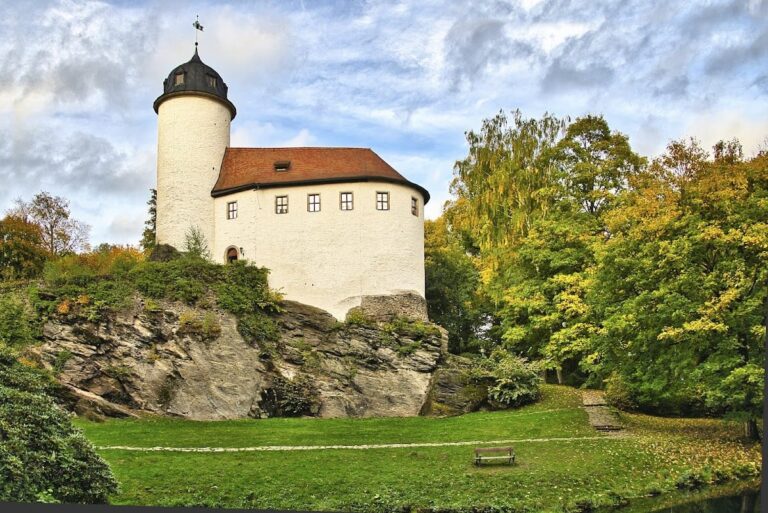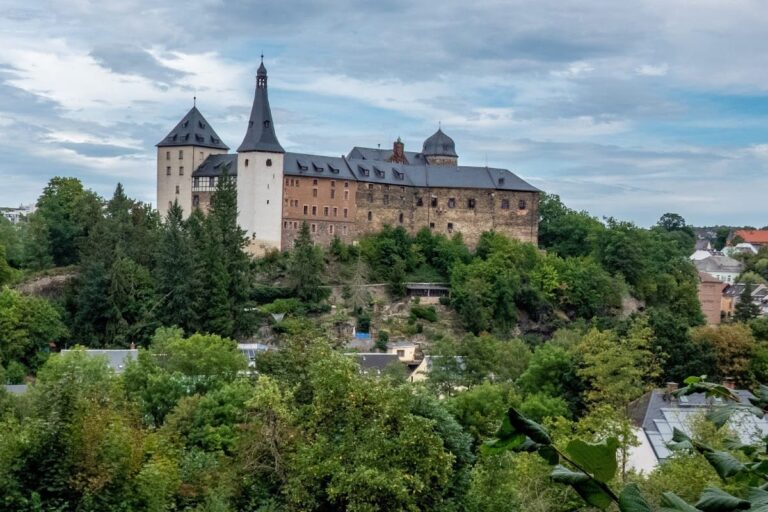Stein Castle: A Medieval Fortress and Museum in Hartenstein, Germany
Visitor Information
Google Rating: 4.4
Popularity: Low
Google Maps: View on Google Maps
Official Website: www.museum-burg-stein.de
Country: Germany
Civilization: Medieval European
Remains: Military
History
Stein Castle, located in the village of Stein within the municipality of Hartenstein, Germany, was constructed by German settlers during the early 13th century. It emerged at a time when German expansion eastward led to fortified sites being established along important river crossings.
Construction of Stein Castle began around 1200 on a rocky outcrop above the southern bank of the Zwickauer Mulde river. Its initial role was to protect a vital crossing over the river and probably to serve as an outer defensive position, or Vorwerk, for the nearby Hartenstein Castle. The first known record of the castle dates to 1233, naming Heidenreich of Grünhain, a minor noble who styled himself “knight of the rock castle,” as its owner.
During the 14th century, Stein Castle’s occupants gained notoriety as robber barons. Notably, Conradus de lapide was accused of various crimes in 1320, reflecting the turbulent atmosphere of the period. Ownership shifted among local elites, including a patrician family from Zwickau known as the Egerers around 1305 to 1350. From 1406 onward, the noble Schönburg family and their vassals maintained control over the site.
One of the castle’s most dramatic episodes occurred in 1455 when Kunz von Kaufungen, then lord of Stein Castle, abducted the sons of Elector Frederick the Gentle, Princes Ernest and Albert, in an event later called the Saxon Princes’ Kidnapping. Prince Ernest was concealed in a nearby site now called the Prince’s Cave. The abductor was captured and executed within that same year.
The castle also played a role in the Great Peasants’ Revolt of 1525. Its serfs attempted to seize the fortress, but the revolt was suppressed when Ernest II of Schönburg returned to reclaim the castle. Afterward, the peasants faced harsh punishments.
In the early 18th century, Stein Castle became the administrative center of the newly independent Barony of Stein, formed by separating it from the County of Hartenstein. This barony encompassed the castle and nearby villages including Wildbach and Langenbach, as well as two abandoned settlements called Nieder-Opritz and Ober-Opritz.
A significant fire in 1732 destroyed much of the lower section of the castle complex. Repairs and partial rebuilding took place, followed by renovations in the mid-19th century, notably in 1846. The Schönburg family held the castle until 1945, when their property was seized during land reforms in socialist East Germany.
Since 1954, Stein Castle has housed a museum dedicated to local history and the castle’s own background. After German reunification, parts of the estate were repurchased in 1996 by Alfred Prince of Schönburg-Hartenstein, who initiated extensive restoration efforts. The castle remains partially accessible to the public today.
In the vicinity, northwest of the main castle, archaeologists identified the remains of a medieval defensive earthwork featuring a large round mound approximately 30 meters wide, along with ditches and ramparts. Formerly mistaken for a motte-and-bailey castle and called “Ur-Stein,” this site was officially protected as an archaeological monument from 1958, while Stein Castle itself received protection beginning in 1971.
Remains
The castle is arranged on a rocky spur overlooking the Zwickauer Mulde river, with a complex of upper and lower wards (Oberburg and Niederburg) forming a roughly rectangular enclosure. The oldest core, the upper ward, dates to around 1200 and was built in late Romanesque style using local stone. It includes a distinctive round bergfried (a fortified tower) rising about 50 meters, featuring a high entrance halfway up the tower to provide defense. This tower was later raised in height during the 16th century and received ornamental Renaissance elements, including a decorative gable cornice, and an 18th-century Baroque dome with small gabled roofs.
Attached to the bergfried is the palas, the castle’s main residential building, which sits upon a sturdy round bastion that once guarded the gate to the lower ward. The palas originally contained a spiral staircase made from roughly hewn fir wood planks linking its floors, and retains a heavy oak door carved with notch-like ornamentation dating to the late 15th or early 16th century.
Beneath the bergfried was a Gothic chapel constructed around 1400, identified by its window tracery and surviving gate jamb fragments. This single-nave chapel featured a large pointed-arch window and exemplified late Gothic architectural traits. It was severely damaged by fire in 1844 and ultimately demolished in 1886 due to its poor condition, though subtle remains were still visible as late as 1981.
The lower ward developed later with significant additions including a pointed round tower in the southwest corner likely erected during the 14th century. This tower stands about 32 meters tall, capped by a steep conical roof, which originally was surrounded by battlements. Together, the three wings of the lower ward and the upper ward formed an almost rectangular courtyard, although historical records from 1835 show an additional tower once stood in a courtyard corner between the east and south wings.
Stein Castle was naturally protected to the south by the Mulde river and augmented with water-filled moats and earthen ramparts during medieval times. These features effectively made it a water castle, controlling both the river crossing and the surrounding terrain. Over time the moats and ramparts were leveled, and the modern roadway encircling the castle appears to follow what was once a defensive earthwork.
West of the lower ward gate stood the former outer bailey, housing several practical buildings including a hunter’s house, sheepfold, and bone mill, connected to the castle by a bridge. At the bailey’s corner was a small round tower with a Baroque dome and lantern, now demolished.
The site included a network of wooden and stone bridges crossing the Mulde river, some of which were covered structures as shown in old illustrations. A toll was charged on the bridges until 1924. A modern steel arch bridge built in the 20th century was destroyed during fighting in 1945 and replaced by a concrete bridge in 1950.
Today, the upper ward functions mainly as a museum showcasing the region’s feudal history, cultural heritage, and exhibits related to the local poet Paul Fleming. The bergfried remains closed to visitors. The lower ward remains in use, hosting forestry administration offices and private residences of the princely family. The southwest corner tower of the lower ward contains a late Gothic ribbed vault and a festival hall, which serves as a venue for concerts and events.
Once displayed in the upper ward residential rooms was the Schönburg weapons collection, encompassing a wide range of historic arms from crossbows to early firearms like needle guns. Much of this collection was lost or redistributed during the East German period. The museum also features a life-sized wooden figure of Streitenberger, the colorful court jester who served under Otto Ludwig of Schönburg-Hartenstein in the 17th century.










